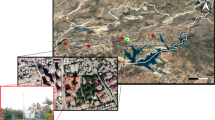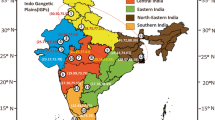Abstract
A precise knowledge of solar radiation flux distribution in each particular geographical location is key to the promotion of solar energy technology. The amount of solar radiation flux can be estimated using experimental data and modeling parameters as well. This research work is based on the use of the RadEst 3.0 ver software to estimate daily solar radiation flux at high altitude mountain area using meteorological parameters such as precipitation, maximum and minimum temperature, and solar radiation of Simikot, Nepal (Lat. 29.967 °N, Lon. 81.833 °E and Alt. 2990.0 m). The radiation is estimated using four different models: Bristow and Campbell, Campbell and Donatelli, Donatelli and Bellocchi, Donatelli-Campbell-Bristow-Bellocchi as the product of the estimated transmissivity of radiation for each model and radiation outside the earth’s atmosphere and compared with measured solar radiation. The model parameters are fitted in two years (2012 and 2015) ground measured data by using iterative procedures. The performance of the models was evaluated using statistical tools such as root mean square error, mean bias error, mean percentage error, co-efficient of residual mass, and coefficient of determination. The graphics and statistical evaluation suggested that among the four models, the Donatelli-Campbell-Bristow-Bellocchi model is better than others for Simikot. The value of statistical tools for this last model are 3.012 MJ/m2/day, −0.029 MJ/m2/day, 2.402%, 0.002 MJ/m2/day and 0.595 respectively. The finding empirical coefficients of different models can be utilized to estimate of solar radiation flux at similar geographical locations in Nepal.






Similar content being viewed by others
References
Abraha M, Savage M (2008) Comparison of estimates of daily solar radiation from air temperature range for application in crop simulations. Agric for Meteorol 148(3):401–416
Allen RG (1997) Self-calibrating method for estimating solar radiation from air temperature. J Hydrol Eng 2(2):56–67
Angstrom A (1924) Solar and terrestrial radiation. Report to the international commission for solar research on actinometric investigations of solar and atmospheric radiation. Quarterly J Royal Meteorol Soc 50(210):121–126
Annandale J, Jovanovic N, Benade N, Allen R (2002) Software for missing data error analysis of penman-monteith reference evapotranspiration. Irrig Sci 21(2):57–67
Bristow KL, Campbell GS (1984) On the relationship between incoming solar radiation and daily maximum and minimum temperature. Agric for Meteorol 31(2):159–166
Chhetri BRK, Gurung S (2017) Estimation of total solar radiation using radest 3.00 software at Jumla, Nepal. Int J Syst Assur Eng Manag 8(2):1527–1533
Dhakal S, Gautam Y, Bhattarai A (2020) Evaluation of temperature-based empirical models and machine learning techniques to estimate daily global solar radiation at Biratnagar Airport Nepal. Adv Meteorol 2020:1–11
Donatelli M, Bellocchi G, (2001) Estimate of daily global solar radiation: new developments in the software radest3.00. In: proceedings of the 2nd international symposium modelling cropping systems, Inst. for Biometeorology CNR, Florence, Italy, 213–214
Donatelli M, Bellocchi G, Fontana F (2003) Radest3.00: software to estimate daily radiation data from commonly available meteorological variables. Eur J Agron 18(3–4):363–367
Golden Software/Surfer. Surfer 13. [Online; accessed 26-March-2019]
GON (2019). Economic survey: Fiscal year 2018/19
Goodin DG, Hutchinson J, Vanderlip RL, Knapp M (1999) Estimating solar irradiance for crop modeling using daily air temperature data. Agron J 91(5):845–851
Hamon RW, Weiss LL, Wilson WT (1954) Insolation as an empirical function of daily sunshine duration. Mon Weather Rev 82(6):141–146
Hassan GE, Youssef ME, Mohamed ZE, Ali MA, Hanafy AA (2016) New temperature-based models for predicting global solar radiation. Appl Energy 179:437–450
Iqbal M (1983) An introduction to solar radiation. Academic Press, New York, NY
Joshi U, Poudyal KN, Karki IB, Chapagain NP (2020) Evaluation of global solar radiation using sunshine hour, temperature and relative humidity at low land region of Nepal. J Nepal Phys Soc 6(1):16–24
Joshi U, Karki IB, Chapagain NP, Poudyal KN (2021) Prediction of daily global solar radiation using different empirical models on the basis of meteorological parameters at Trans Himalaya Region. Nepal BIBECHANA 18(1):159–169
Kipp and Zonen (2008) Manual CMA and CMP series, Instruction Manual. version:0806. Kipp & Zonen, B.V. Delftechpark 36, 2628 XH Delft, The Netherlands
Kudish A, Wolf D, Machlav Y (1983) Solar radiation data for beer sheva. Israel Solar Energy 30(1):33–37
Lamsal H (2019) Nea to connect all households with electricity by 2022. Republica
Li H, Cao F, Wang X, Ma W (2014) A temperature-based model for estimating monthly average daily global solar radiation in China. Sci World J 2014:1–9
Nage GD (2018) Estimation of monthly average daily solar radiation from meteorological parameters: sunshine hours and measured temperature in Tepi, Ethiopia. Int J Energy Environ Sci 3(1):19–26
Olomiyesan B, Oyedum O, Ugwuoke P, Abolarin M (2017) Evaluation of some global solar radiation models in selected locations in northwest, Nigeria. Open Access J Photo Energy 1(1):1–6
Pandey C, Katiyar A (2010) Temperature base correlation for the estimation of global solar radiation on horizontal surface. Int J Energy Environ 1(4):737–744
Podestá GP, Núñez L, Villanueva CA, Skansi MA (2004) Estimating daily solar radiation in the argentine pampas. Agric for Meteorol 123(1–2):41–53
Poudyal K N (2015) Estimation of global solar radiation potential in Nepal. Ph D Thesis, IOE, Tribhuvan University
Poudyal KN, Bhattarai BK, Sapkota B, Kjeldstad B, Daponte P (2013) Estimation of the daily global solar radiation; nepal experience. Measurement 46(6):1807–1817
Poudyal KN, Bhattarai BK, Sapkota B, Kjeldstad B (2012) Estimation of the daily global solar radiation using RadEst 3.00 software-a case study at low land plain region of Nepal. J Nepal Chem Soc 29:48–57
Research Centre for Industrial Crops Agriculture Research Council. Radest 3.00 version. [Online; accessed 26-March-2019]
Rivington M, Bellocchi G, Matthews K, Buchan K (2005) Evaluation of three model estimations of solar radiation at 24 uk stations. Agric for Meteorol 132(3–4):228–243
Shrestha JN, Bajracharya T, Shakya S, Giri B (2003) Renewable energy in Nepal-progress at a glance from 1998 to 2003. In: proceedings of the international conference on renewable energy technology for rural development (RETRUD-03), pages 12–14
Team, GEAW et al. (2012). Global energy assessment. Cambridge Books
Trnka M, Žalud Z, Eitzinger J, Dubrovsky M (2005) Global solar radiation in central European lowlands estimated by various empirical formulae. Àgric For Meteorol 131(1–2):54–76
UNEP/GEF, AEPC, GoN (2008). Solar and Wind Energy Resource Assessment in Nepal (SWERA)
WECS, Water and Energy Commission Secretariat (2010) Energy sector synopsis report, Government of Nepal
Acknowledgements
Authors sincerely express deep thanks to FAO-SDRN Agrometeorology Group, Rome, Italy and ISCI- Crop Science, Bologna, Italy, for providing free version of RadEst ver. 3.00 software and manual through the website for academic purposes. Likewise authors greatly thanks to Department of Hydrology and Meteorology (DHM), the Government of Nepal for providing meteorological data. Authors are grateful to thank Nepal Academy of Science and Technology (NAST) for providing partial financial support to forward research work. Authors would like to give special thanks to R. Bachchan, faculty members and staffs of Dept. of Physics, Patan Multiple Campus, TU and Pulchowk Campus, TU
Funding
No funding was received for conducting this study.
Author information
Authors and Affiliations
Corresponding author
Ethics declarations
Conflict of interest
The authors declare that they have no conflicts of interest.
Additional information
Publisher's Note
Springer Nature remains neutral with regard to jurisdictional claims in published maps and institutional affiliations.
Rights and permissions
About this article
Cite this article
Joshi, U., Chapagain, N.P., Karki, I.B. et al. Estimation of daily solar radiation flux at Western Highland, Simikot, Nepal using RadEst 3.0 software. Int J Syst Assur Eng Manag 13, 318–327 (2022). https://doi.org/10.1007/s13198-021-01234-4
Received:
Revised:
Accepted:
Published:
Issue Date:
DOI: https://doi.org/10.1007/s13198-021-01234-4




